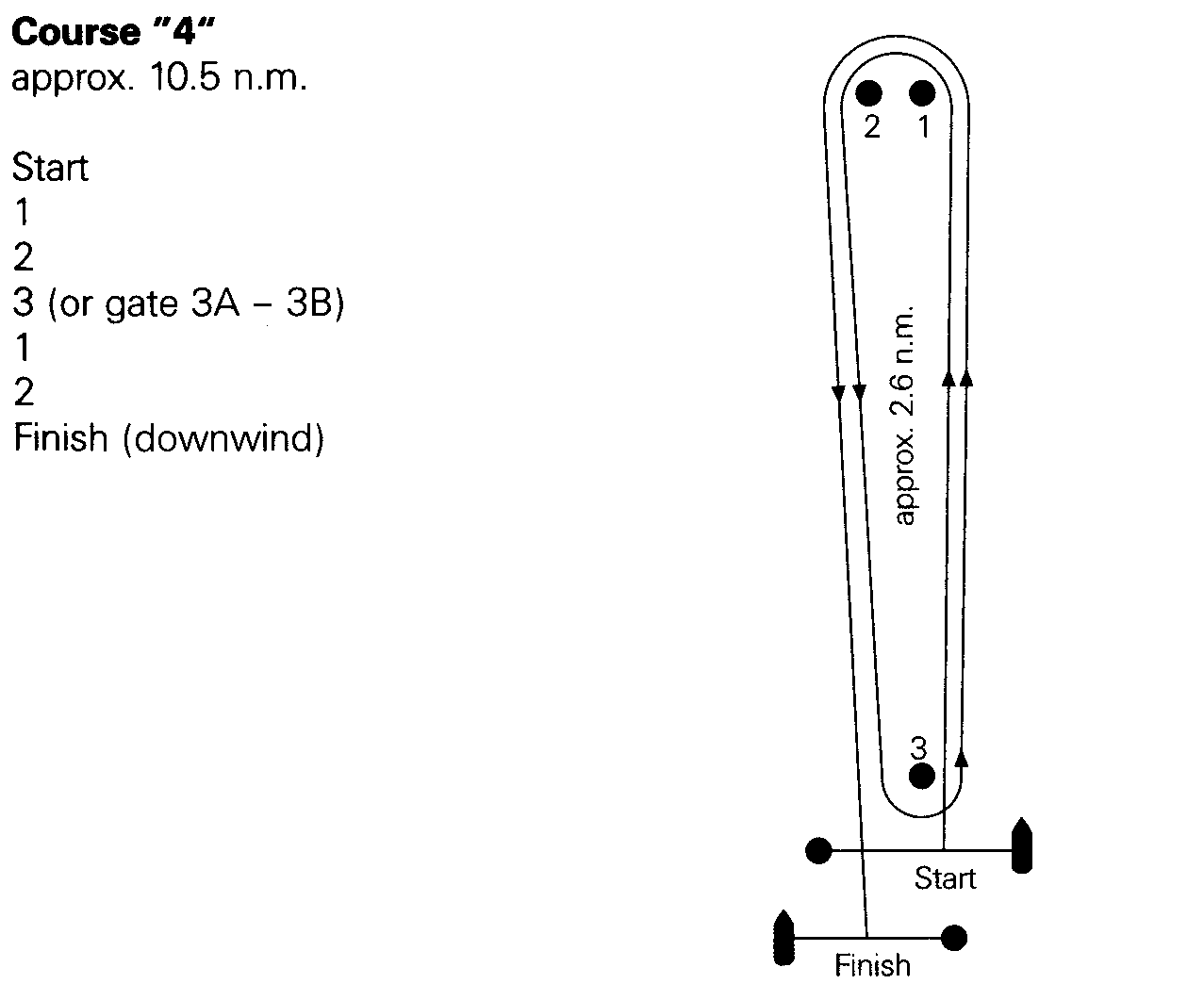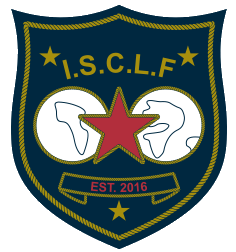Synthetic Sails
During the 1950’s sails began to be made out of synthetic materials. First nylon was tried, but the material proved to be too stretchy. Orlon was somewhat more stable and sails made from this material appeared in the mid-1950’s. Finally Dacron came on the scene in the late 1950’s. While it is questionable whether Dacron sails were superior to cotton sails as long as the cotton sails were in top condition, it was obvious that Dacron sails held their shape better and were not affected by getting wet, something which is rather hard to avoid on any boat but in a Star particularly.
With synthetic materials came the ability to have windows placed in the sails. At first these windows were small, the total allowed measuring three square feet. With window space at such a premium, only windows in the lower mainsail were used. Today a total of a little more than 8 square feet is allowed and windows are placed both in the main and the jib.
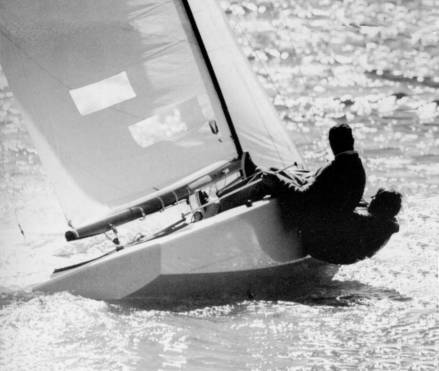 |
|
Buddy Melges & Andreas Josenhans
|
In 1978 Buddy Melges won the World’s using a heavily yarn-tempered Dacron. This created a real revolution in the art of sailmaking. The Widgeon, # 6346, had many innovations, not the least of which was the elimination of backstay tracks in favor of an under-deck wire backstay system. Travelers were still in use with the traveler track just aft of the rudderpost, but Widgeon had the track recessed at the center line and then bowed up to about 2" above the deck at the rails. These items, combined with a computer-designed keel, extra stiffening provided by bulkheads, and buoyancy tanks on the floor to make the boat self-bailing made the boat radical for its time.
Changes in the Jib Luff Wire System
During the 1950’s jib construction underwent a change. Up until this time the jib was hanked onto the jibstay wire. Then Murphy & Nye came out with a jib which had the jib luff wire sewn into it. The luff wire was purposely sewn in a little long so that as the pressure on the jib luff cloth increased it could stretch until the slack in the wire was taken up. Once the jib was raised the halyard was locked aloft and the wire in the jibstay took the place of the standing jibstay. By 1960 this had given way to having the jib luff wire floating freely inside the jib luff cloth at the tack. A separate shackle had to be installed on the deck at the jib tack which independently controlled the amount of tension on the jib luff cloth. The next step after this was to have a threaded jib. In this operation the jibstay had to be disconnected and threaded down the pocket in the jib luff.
After loosing a few masts over the back the Governing Committee decided that the jibstay could not be disconnected at anytime to raise the jib. Thus boats which wanted to continue the practice of threading the jibstay into the jib luff had to have a second wire outside the jib luff. This second wire was put to use in pulling the mast forward on the runs, but going upwind was always a nuisance as it was hard to find the right tension to keep it from flailing about while at the same time not have any appreciable tension on it. The system of having two separate jibstays remained in use up until the last of the black aluminum mast days. Now, in a sense the principal of jib construction has come full circle, with the jib being attached to the standing jibstay, which has become the supporting jibstay once again. Now however the jib is zippered onto the jibstay rather than being hanked to it.
Jib Fairlead Adjustment
Jib fairleads have run the range from being a single loop on the deck to being fully adjustable both fore and aft and athwartship. As designed the Star had a single loop on the deck. By 1924 when Bill Inslee wrote his article on tuning it appears that his fairleads were fully adjustable in terms of positioning, although it seems that this could only be done manually. Despite the obvious need to have some adjustment of the fairleads certain builders continued to offer only a single loop right up into the 1950’s.
With the old high-cut jibs the fairlead was positioned about 10" aft of the mast and about 17" off center. Many boats had tracks running along the 10° line so that the fairlead could be adjusted fore and aft, but not laterally. However, Barber haulers came into use in the early 1960’s so there was no need for lateral adjustment. When the jib slot needed to be opened up this was accomplished by pulling on the Barber hauler.
By the late 1960’s "deck sweeper" jibs took the place of the standard high-cut jib, but the angle at which the fairlead should be placed remained the same. In the articles about tuning written by Malin Burnham and Lowell North there was a difference of opinion as to what degree off center the fairlead should be placed. Malin called for 9° whereas Lowell mentioned 10° to 14° depending on the strength of the wind. As the picture below shows, Lowell had a single jibsheet fairlead track along the 10° line and Barber haulers to trim the jib off the 10° line.
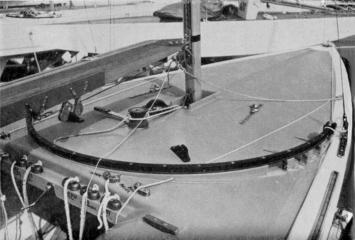 |
|
In 1969 Lowell North bought a Buchan boat, # 5392. This shot of the deck layout shows wooden spars. Note the single jib fairlead track on the 10° line and the Barber hauler running from a jam cleat to the rail and then back to the boom for storage. This was the last year in which only wooden spars were allowed.
|
When the Star was designed the jib sheet was just a single line led from the jib clew through the jib fairlead and from there to a cleat. By the 1930’s it was felt that there was need to be able to pull on the jibsheet tighter in windier conditions. A winch was placed on the deck just forward of the cockpit and commonly a cleat was installed in center of the forward edge of the cockpit in order to cleat the jib. It wasn’t until the 1970’s that the two-part jibsheet system began to appear, eliminating the need for the winch.
Cunningham
About the same time that jib cloth downhauls were introduced onto Star boats Cunninghams began to be used to tension the mainsail’s luff boltrope. At the very least this made life easier for the crew but it also made adjustment to the mainsail’s luff boltrope more efficient. In terms of rigging this was not a very difficult changeover. Instead of having the crew jump up on the deck to slide the gooseneck up or down on the gooseneck track the boom was allowed to be left at the black band and a line was led to the mainsail tack cringle, or in some models of sails to the Cunningham cringle which was a few inches above the tack cringle. There was not standard setup for this: some had a cleat just below the black band to which the Cunningham rope was cleated and others led the Cunningham rope below deck, sometimes to a block-and-tackle arraignment.
Boom Vang
It is hard to imagine today, but up through the mid-1950’s the major way of keeping the boom from lifting while on the run was to have the crew sit on the boom! During the late ‘50’s various methods of doing this mechanically came into being. One was to have two or more hooks along the rail into which another hook hanging on a wire suspended from the boom was placed. This wire was led below deck, usually to a boom vang drum. The trouble with this boom vang was two-fold: 1) every time the skipper wanted to gibe the crew had to unhook the vang as part of his preparation for the gibe, and 2) when the wind was really blowing it was really quite some chore to unhook the vang.
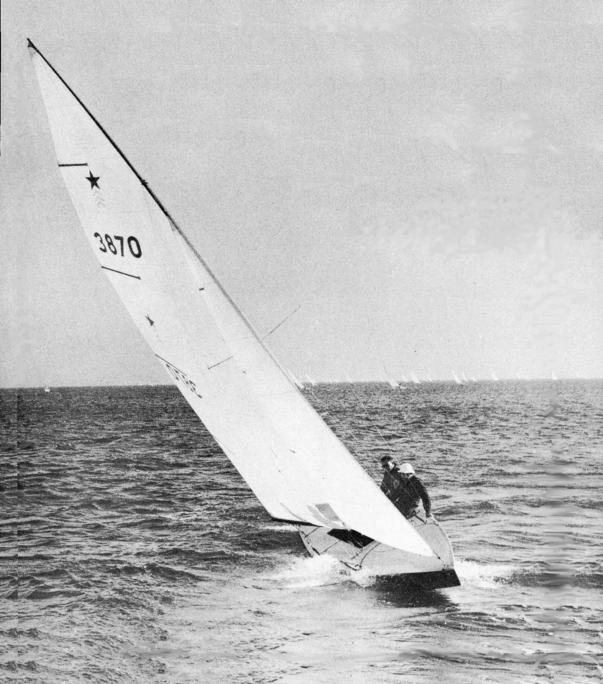 |
|
Duarte Bello, designer of Star Fittings
|
Finally, in the late 1960’s the circular vang track became more common, but competing against this was the boom vang lever which began to show up in the mid-1970’s. The lever was attached to a channel post which was directly behind the mast and bolted to it. The only real defect with the boom vang lever was that a depression aft of the mast had to be made so that the lever would have enough leverage.
Mast Rake and Position
Over the years greater and greater mast rake had been used. When the tall Marconi rig first appeared the general tendency was to keep the end of the boom about 1’ to 1½’ feet off the transom when hard on the wind. By the late 1950’s 1’ was more the norm, and by the latter part of the 1960’s two-blocking the boom is mentioned by Malin Burnham in his article on tuning. Since the jibstays were not of a standard length there was no mention of the magic number which is used in today’s tuning guides.
Because the masts were not bent as much as they are now the location of the upper and lower shrouds on the chainplate was reversed. The uppers were attached to the chainplate at about the front of the mast and the lowers were positioned about 1" to 1½" in front of the mast.
The mast was positioned so that the end of boom (or if it had the black band the band) came just to the transom or slightly inboard of it.
General Principles
The general principle which operated throughout the 1950’s and 60’s was once you had the boat properly set up the harder it blew the harder you pulled. In light to moderate breeze the jib was set just tight enough so that the first thing to show signs of luffing as you pointed the boat up was the first few inches of the luff of the main. As the wind picked up the jib was trimmed harder, the mainsheet pulled in harder, the outhaul and downhaul / Cunningham tightened, and the traveler eased.
In San Francisco particularly during the late 1950’s when the wind got to its customary 25 knots it was common to see a huge bubble in the main with just the jib and batten area of the main working. This was because both the jib and the main were strapped in really hard and the traveler was let off until the end of the boom was above or beyond the corner of the stern. Whether this was fast or not is questionable: the San Francisco fleet at the time was not very competitive with the rest of the West Coast boys.
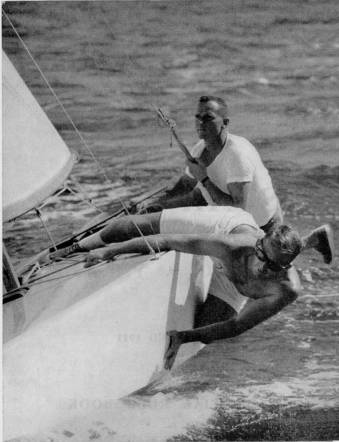 |
|
Lowell North and Jim Hill on North Star, #3877 in 1957. Note the amount of backstay rope.
|
As mentioned above, the original purpose of the lower backstay was to keep the mast from pumping in rough seas and became common on boats in San Francisco and the West Coast generally in the late 1950’s. Collective memory can’t exactly place when the use of lower backstay to power up boat came into play. However, photos from the late 1950’s of Lowell North’s North Star, #3877, show what looks like very substantial block-and-tackle on the lower backstay, so perhaps even by this time some few skippers were using the lower backstay for more than just stabilizing the rig.
Despite this conjecture even by the mid-1960’s when Malin Burnham and Lowell North wrote articles for Starlights about tuning a Star neither of these articles mentions that the lower backstay was used to power up the rig. They agree that the purpose of the lower backstay was to keep the mast from pumping in rough conditions. Bill Buchan wrote an article for the November, 1980, issue of Starlights and again there is no mention of the lower backstay being used to power up the mainsail. Bill noted recently that "once you found the magic adjustment spot they weren't changed all that much."
ALUMINUM SPAR ERA
In 1971 spars made of materials other than wood were first allowed by the Star Class. The new paragraph in the specifications for spars read, "Other materials. Spars of aluminum, fiberglass, or plastic, or combination of fiberglass and plastic with wood, are permitted…" As Alan Holt pointed out in his article Modern Mast Technology, "The Star Class was one of the last one design classes to adopt aluminum spars as there was much trepidation that aluminum would not be as good as wood. Aluminum tip weight was set so that the ultra light wood masts would not have an advantage over the proposed metal masts. It was soon evident, however, that aluminum spars were stiffer and/or smaller (less windage) than wood for the same weight, cheaper, stronger and more maintenance free - an obviously unbeatable combination. Aluminum spars dominated the first major regatta after their introduction."
While Alan, who runs Spar Tech with Richard Gates, focuses on aluminum spars in the article, mention should be made that fiberglass and composite spars were also experimented with, but these experiments did not prove to be successful.
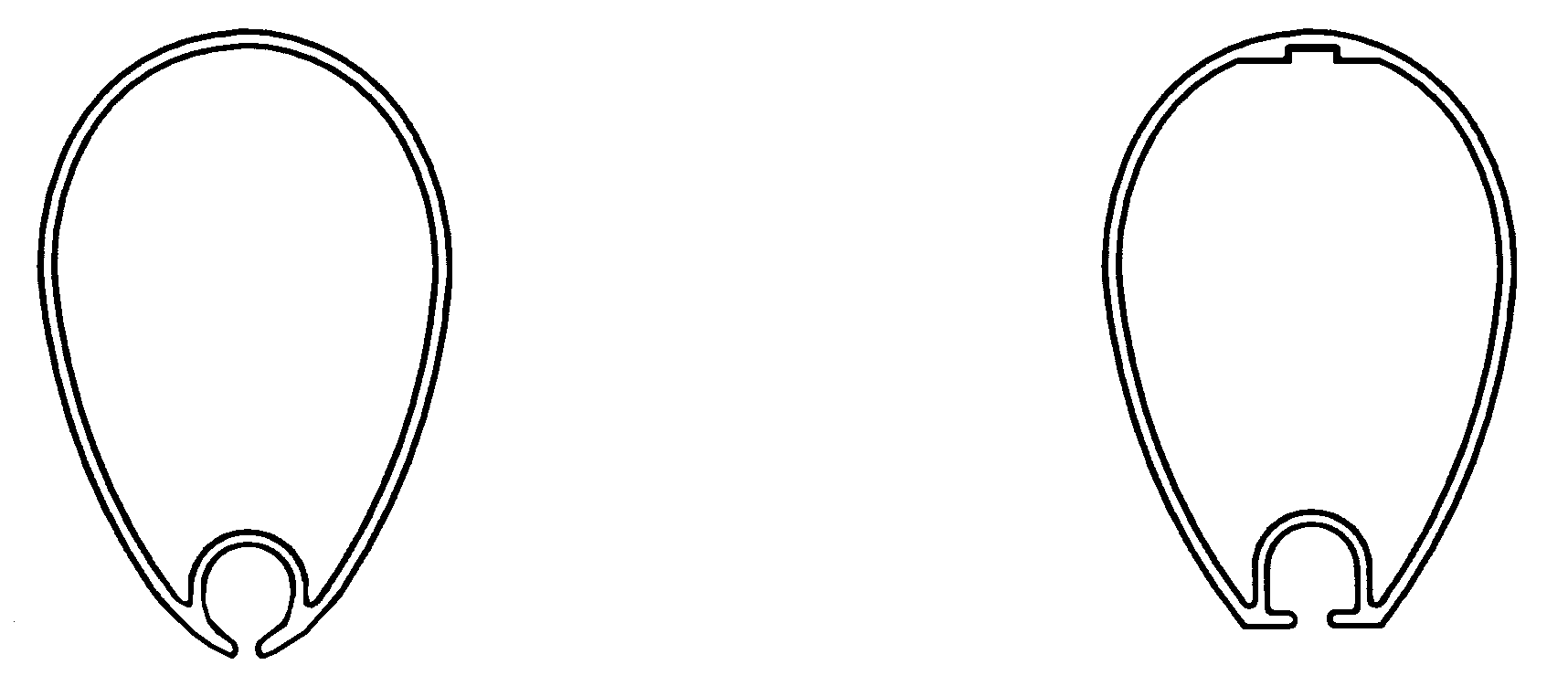 |
|
"D" and "F" section masts. Note the extra material on both the leading edge and the aft edge of the "F" section mast.
|
 |
|
The oval, sharp-edged trapezoidal, and rounded-edged trapezoidal boom sections.
|
Booms have undergone more radical design changes. Oval sections were normally used with the black D section masts. The sharp-edged trapezoidal section came in 1987. This was replaced by the present rounded-edged trapezoidal section in 1989.
From the information supplied in this article it can be seen that there are many options in terms of how a Star is set up, both in deck layout and in how the mast is rigged. If Stars look pretty much the same today it is because trial-and-error has narrowed down the options to fairly limited parameters and there is general agreement on how the boat is to be set up. This does not limit from the individual boat owner from trying out new ideas, or reusing old ones!
References:
Bill Buchan: Some Thoughts on Upwind Speed, Starlights, November, 1980.
Malin Burnham: Tuning and Techniques, Starlights, September, 1966 & May, 1967.
Alan Holt: Modern Mast Technology, Starlights, November, 1980.
William L. Inslee: Fitting out Your Star, Starlights, April-May, 1924.
Lowell North: Tuning to Win, Starlights, June & July, 1967.
Walter von Hütschler: Little but Perfect, Parkman Yachts, 1940.
Thanks to Bill Buchan, John MacCausland, Mark Reynolds and Jack Button for supplying information for this article.
HIKING TECHNIQUES THROUGH THE AGES
The importance of getting crew weight over the side on a Star has been recognized since the earliest championship events. In 1924 Bill Inslee, who won the first two Gold Star events held by the Class in 1922 and 1923, wrote an article for April-May issue of Starlights which talks about getting the most out of the Star boat. Concerning hiking, his mentions that it is "essential is to put the boat in balance with the keel in proper position within the range allowed to float the boat on proper sailing lines, and still permit of the skipper and crew placing their weight where it will exert the most leverage and do the most good in holding the boat up in a strong breeze."
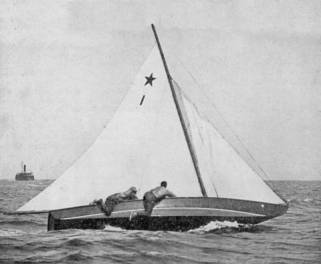 |
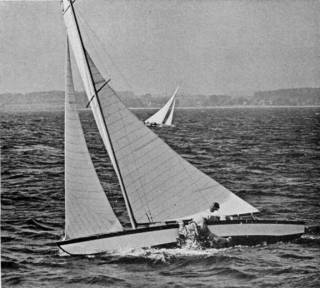 |
| Here we see Bill Inslee with crew Robert Nelson on their way to win the 1923 World’s.
|
Walter von Hütschler had his crew Egon Beyn carry this hiking technique to another level with the crew hanging onto the side of the boat. Here we see them on their way to win the 1939 World’s.
|
The hiking vest was allowed in 1981. The combination of hiking straps and hiking vest have changed completely the physical attributes of the premium Star crew. Paul Cayard observed that at 205 lbs. he was a standard sized crew when he sailed with Bill Gerard in the 1978 World’s.
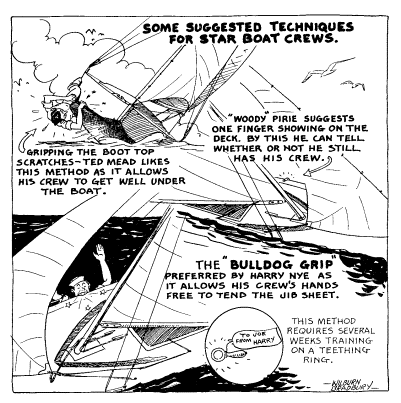 |
| The 1940 Log carried this cartoon spoofing the hiking methods of the various top crews.
|
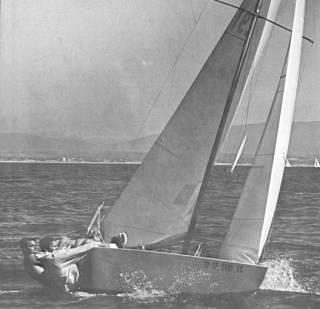 |
| Hiking straps were first allowed in 1969. Here we see Dennis Conner with his Menace in 1971 doing a double mini-hike. Check out the crew: not exactly the sort of beef which is represented by most top-level crews today.
|
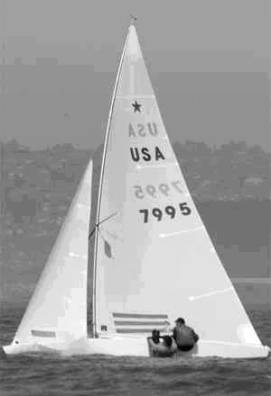 |
| Now 250 lbs. is considered to be a little on the light side. The team of Mark Reynolds and Magnus Liljedahl, seen here on their way to win the 2000 Olympics, epitomizes the top flight crews of today.
|
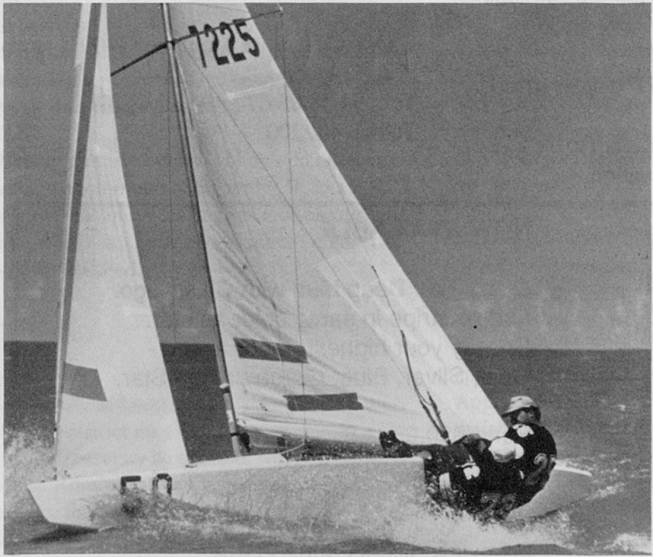 |
| Steve Erickson and Paul Cayard on their way to winning the 1988 World’s. Steve weighed at the time somewhere in the 250 lbs. range.
|
BREAKTHROUGH AT THE 1978 WORLD’S
By Paul Cayard
Flying home from Europe recently, I began thinking back over my career and my thoughts focused on my first Star World’s Championship. The year was 1978, the venue was San Francisco and the characters are now famous to all of us. For a change of pace I thought I would take a look back at this event. The protagonists are legends of our sport. I think you’ll enjoy the story.
At 18 years of age, 6’ 2" and 205 pounds, I was the perfect 505 crew. However, Tom Blackaller had taken notice of me and asked me to crew for him in the 1978 Star North American Championship in Toronto as a lead up to the Star World’s in San Francisco later that year. I drove the boat from San Francisco to Toronto, cleaned it, rigged it, got it measured and waited for Tom to fly in the night before the first race. Such is the life of a keen young, aspiring, sailor. The championship was not to be as there was no wind to be found in Toronto that year. But I was exposed to the world of "Big Time" sailing. Durward Knowles, Buddy Melges, Bill Buchan, Joe Duplin, Dennis Conner, Lowell North, Ding Schoonmaker and of course Tom Blackaller were all present. So was a lesser-known boat builder named Bill Gerard. As Tom was to sail the Star World’s with his regular crew, Ed Bennett, Bill asked me to crew for him and as keen as I was, I said sure.
Star sailing in those days was a "man’s" sport. No hiking vests, no self bailing cockpits and sliding track backstays that had to be tacked. What this meant was that the crew was hiked out over the side hanging on by his ankles, pulling on a rope that was attached to a bilge pump and retracted by shock cord, and tacking and releasing the backstays on tracks at each tack. It was a workout to say the least. But because you had to hang out over the side with no support, 205 pounds was not that far off the pace for weight. Of course there were exceptions; Ron Anderson, crewing for Dennis Conner at 275 could hike the whole way and Bill Munster at 285 crewing for Malin Burnham could most of the way.
To say that Bill Gerard and I were underdogs was an understatement. The best Bill had ever done in the World’s was 15th and this was my first. But to our good fortune, two days before the World’s started, Buddy Melges came up to Bill and, handing him a bag of sails, said "Here, give these a try." We had no idea that we had in our hands was pure speed…an innovation the likes of which comes around once every 10 years in one-design sailing and produces speed that makes a significant difference. The sails in the bag were the first of the heavily yarn-tempered Dacron cloths and cut into the flattest set of Star sails ever seen. Buddy brought five suits to San Francisco; two for himself, and he gave one set to us, one to Ding Schoonmaker and one to our current ISAF president Paul Henderson. Little did anyone know that those five suits would win every race in that regatta. The standard in the class at the time was the North "DC2" main with a "TA4B" jib. "DC" stood for Dennis Conner, the reigning World’s champion having won every race at Kiel the year before. But the DC2 would be too full for the strong wind of San Francisco Bay once Buddy Melges came blowing off the starting line in truly a different gear.
In the first three races of the regatta, the story was told. Buddy first, Dennis second and Tom third in each race. Buddy would come off the line and within five minutes it would look like he had started 30 seconds over early. With Andreas Josenhans at 255 holding the boat down and the supper flat supper hard "SF" main, Buddy was untouchable. There was nothing that stalwart Star Champions Blackaller, Buchan and Conner could do to equal Buddy’s speed. Through excellent sailing and experience in the class, Blackaller and Conner dragged their extra full sails around the course better than anyone else but Buddy was in a league of his own.
There were 99 boats at the World’s that year, the biggest fleet ever to that date. At the first windward mark of the first race five boats sunk, all but one being retrieved off the shallow bottom of the Berkeley Circle. A relatively short 2 mile beat, a shiftless 20-25 knots of wind, and 99 boats was a recipe for carnage. Places 30-70 arrived at virtually the same time. A scene like that had never been seen before. In fact, the first leg of a Star World’s race is now 2.75 miles for this reason.
After three races, Ding Schoonmaker gave up on his North sails and went for the Melges sails and proceeded to win the next two races. Buddy finished second or third in each and virtually sewed up the regatta without having to sail the last day.
The last race is a historical one. We were having our best race in 2nd place fighting it out with the current ISAF President, Paul Henderson for the win. Henderson was the better sailor on the day and won the race, the only race he has ever won in the Star World’s. I am sure it is one of his fondest memories.
In the final tally, Melges won the World’s (the first of two in a row) and his legend continued to grow in yet another class. The win also launched Melges as the boat builder and sailmaker of choice in the Star class at that time. He must have sold 400 suits of sails and 20 boats in the year following his win. Dennis Conner finished second, Tom Blackaller third, Gerard/Cayard fourth and Ding Schoonmaker fifth.
A lot of water has passed under the bridge since that regatta.
THE DEVELOPMENT OF STAR CLASS COURSES
From the very first Star Class Log published in March, 1922, the courses for the major championships have been described by the Class. On page 21 of the 1922 Log there is the following:
COURSES
The course shall be laid out in open water and as far as reasonably possible, away from head-lands, shoals, or other local conditions tending to favor a person possessing local knowledge. The courses shall be triangular and not less than eight nautical miles. One course out of three or two courses out of five, etc. may be to windward and return.
In the 1924 Log the description of championship courses was elaborated upon:
COURSES
The course shall be laid out in open water and as far as reasonably possible, away from head-lands, shoals, or other local conditions tending to favor a person possessing local knowledge.
The courses shall be either triangular or windward and leeward (varied if possible) and sailed twice around, making a total distance of ten nautical miles or more. No fixed marks indicating shoals, rocks, or near shore, such as government buoys, light-houses, etc. shall be used as marks of the course. In the event that the turning marks (stake boats) are not clearly visible from all parts of the course, a marker boat (large boat with a distinguishing flag displayed) shall be used in order to make the marks easy to locate.
The general locality of the courses must be submitted to the I.E.C. for approval, and circulars containing complete instructions as to signals, tides, and course must be furnished to each contestant, including a chart of the course.
In the 1927 Log the description of championship courses was further refined although the basic idea of having either a triangular course twice around or a windward-leeward course twice round remained the basic principal. However, a time limit of 3½ hours was added. This description continued to be used with some minor additions and clarifications up until the 1960 Log.
Starboard and Port Roundings
Mention should be made that marks could be rounded either to port or to starboard, depending on the signal displayed by the race committee boat. Judging from the movies taken of the World Championships from the 1930’s through the late 1950’s it appears that both roundings were used equally. However, it was very evident in these movies that starboard roundings, especially as the fleets got bigger and more evenly matched, made life really miserable both for the boats coming up on the mark on port and also after rounding making it at times close to impossible to fall off onto a run until the starboard tack boats had passed. Concerning the disappearance of starboard roundings in the late 1950’s Bill Buchan has the following observation:
There was a World's, most likely in the mid to late 1950's, perhaps Italy in 1956, where the boats that rounded the weather mark couldn't fall off to go downwind in the face of all the starboard tack boats approaching the mark. I know that when I sailed the Portugal World's in 1962 the Race Committee wanted to have us round the marks to starboard because they felt it was unsafe for the fleet to round on port and then head offshore on the reaching legs into the open ocean. The uproar from the fleet at the skippers’ meeting led me to believe that sometime in the recent past there must been an experience that left an indelible impression on those skippers that were there as they wanted no part of any racing that called for starboard roundings. The RC dropped the idea then and there and that's the last time I ever heard of it being brought up.
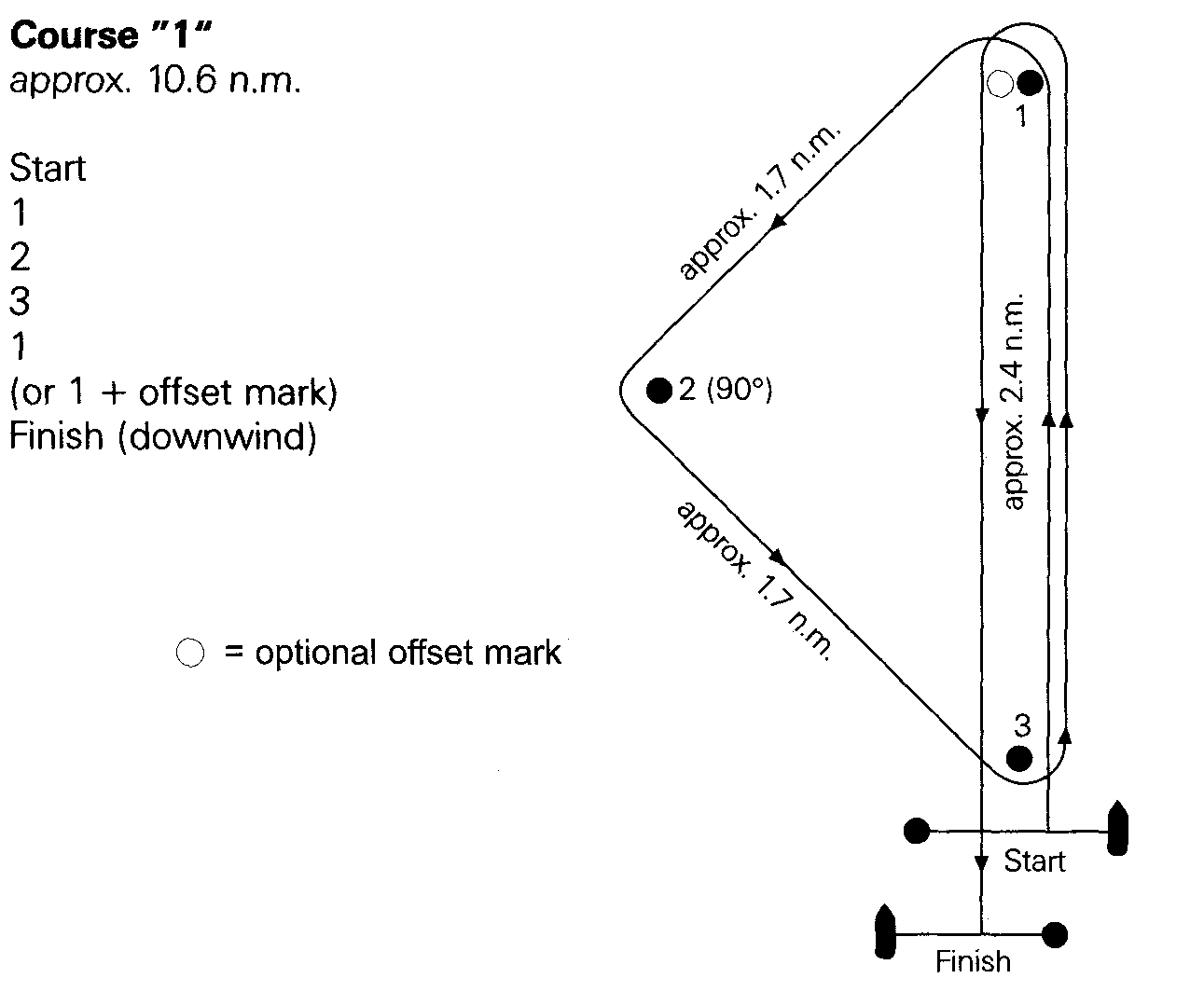 |
|
Gold Cup Course
|
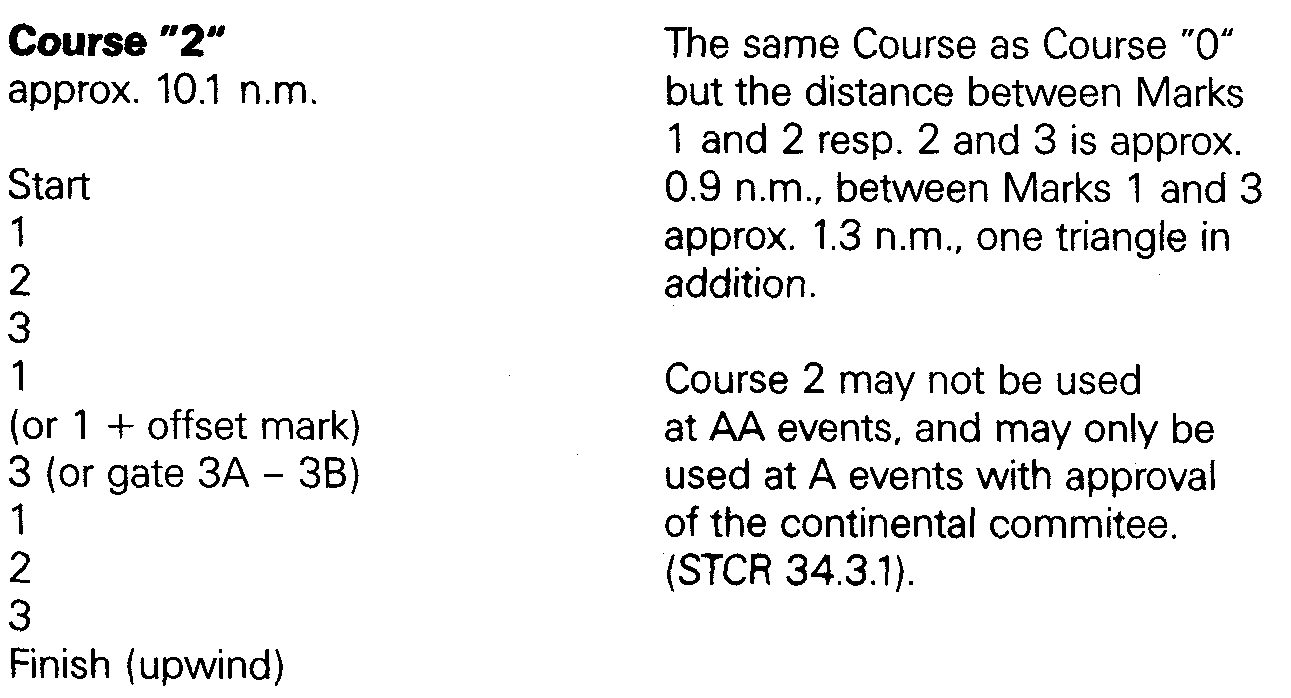 |
|
|
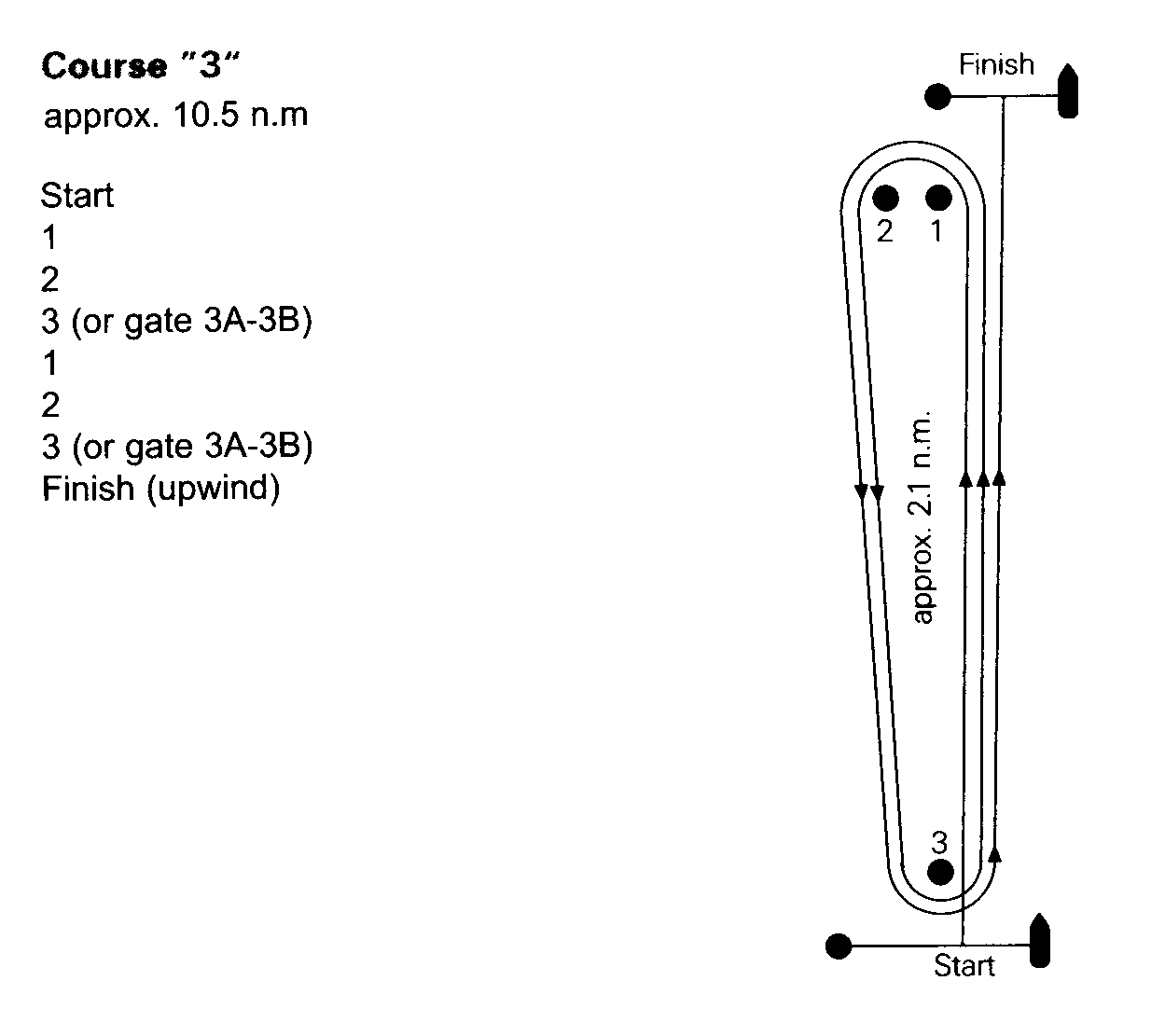 |
|
|
In the 1960 Log there was the first major change in course description since the Logs first came out. Only one course, called at the time "the Gold Cup Course", now Course 1, was to be used at the World’s Championship. The course description read as follows:
2. Races shall be held in open water as free as possible from headlands, shoals, obstructions and aids to navigation. Aids to navigation, unless otherwise specified, must be left on the required or channel side.
3. The course shall be an isosceles triangle, followed by a windward and return which is accomplished by omitting the right angle mark from the triangle on the second round, totaling approximately ten nautical miles. The course can not be shortened.
The Addition of Other Courses
By 1962 it was recognized that for A (now called "Silver") events and below sometimes the waters of the host club could not be run on such a course. The Gold Cup Course became designated as Course 1 in the 1962 Log and the present Course 2 was introduced as an alternative course for events taking place on restrictive waters.
Course 0, known as the "Olympic Course" was added to the list of possible courses in the 1969 Log.
Course 3 was added in 1975 but it was not until 1994 that Course 4 was added.
It should be noted that theoretically for all of these courses the marks can be rounded either to starboard or to port since the direction of rounding is not specified in the course descriptions given in the Logs. However, in the 1996 Log illustrations of the five Star Class courses appeared for the first time, and in these port roundings are shown.


